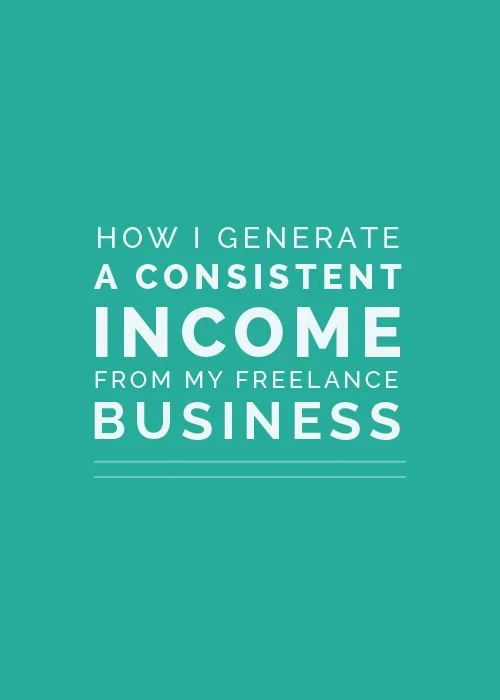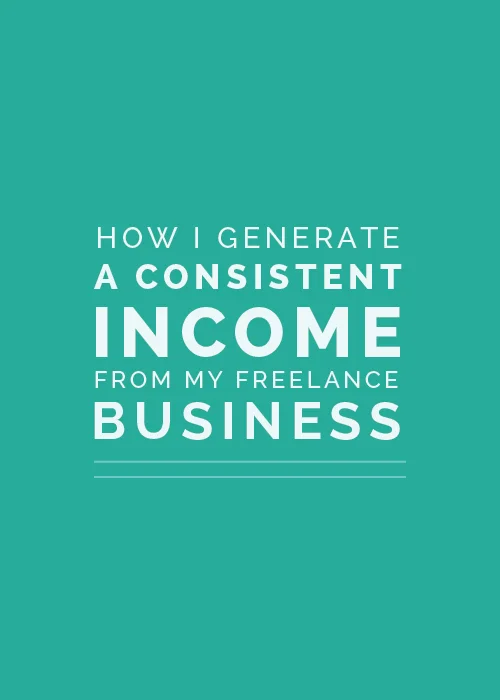Passion gets you started, but strategy keeps your business running. Successful entrepreneurs know that in order to pursue what they love, they have to be smart about how they operate their business. And a business cannot operate without money.
Money can be an uncomfortable topic, but it’s a necessary part of entrepreneurship. While I love my job and consider myself blessed to design for clients all day long, Elle & Company is a business, not a hobby. In order to keep things running and bring in a steady income, I’ve had to be strategic and intentional about how I generate a profit from this business.
In typical Elle & Company fashion, I’m laying it all out for you in today’s post. Here are some insights on how I’ve created a consistent income from my freelance business.
Thank you to all of you who took the time to respond to Friday’s reader survey. We have been blown away by the feedback we’ve received, and the information you’ve provided has been extremely helpful for us (especially in light of our upcoming project!). We’re leaving the survey open for submissions until today at 11:59pm, just in case some of you didn’t have the chance to weigh in with your thoughts. We’re grateful for each and every one of you.
1 | I streamlined my process to streamline client payments
Consistent income is hard to come by when you’re a freelancer. Before my 2-week design process, I booked clients, finished projects, and invoiced clients at random dates throughout the year, which meant that my income varied from month to month. It’s difficult to budget and take care of your expenses when you don’t know exactly how much you’ll be bringing in on a monthly basis, so I needed to come up with a better system.
My 2-week design process has added much more consistency to my monthly income.
In order to book a spot in my design queue, I require a 50% nonrefundable deposit and a signed contract. The deposit ensures that each client is serious about working with me, and it also compensates the time I spend designing a brand and website before I send an invoice for the remaining 50%. The final payment is always due on the last Friday of the design project, after the designs are approved and before I hand off the final design files. So I know that just about every 2 weeks (I schedule some off-weeks in between clients every once in a while), I can expect a client payment.
While I can never predict when a client will book, I do know how many spots I have available in my design queue throughout the year, which allows me to know exactly how much money I’ll bring in from design clients for 2015. After I set aside a certain percentage for taxes and business savings, I can easily divide that money into 12 if I want to be paid once a month, or 24 if I want to be paid twice a month.
Takeaway:
I know that my process might look very different from yours, but you can make this system work for you by designating a certain number of spots in your project queue and creating a streamlined payment system for your clients.
Do you have a service-based business? This post might be helpful for you, too: My No-Fuss Formula for Pricing My Services
2 | I varied my income sources to lessen the risk
Every freelancer fears a slow month. It can be risky to put all of your eggs in one basket with a shop or single design service, especially when your business is in its early stages and your audience is still fairly small.
In order to take my business full-time last summer, I knew that I couldn’t rely solely on my design work to bring in a steady income. I launched my design services a month or two before making the leap to full-time, and I wasn’t at a point where I was booking clients months in advance. In order to lessen the risk of a slow month, I knew that I needed to bring in multiple streams of income.
That’s where the Library came in. I used some of my previous designs to get it up and running and I’ve been adding to it over time ever since. The Library is subscription-based and the number of subscribers has steadily increased with each month, which has created another fairly consistent income stream for Elle & Company and takes some of the pressure off of my design services.
The Adobe Illustrator e-course has recently created another income stream for our business. While it doesn’t generate a consistent monthly income, it generates the greatest amount of income over a shorter amount of time.
By diversifying our streams of income, we’ve been able to lessen the risk of a slow month and bring in more money. This has been especially important as our business continues to grow, because we can now afford to bring on help and outsource certain tasks. We’ve also been able to put some income streams directly into business savings to prepare for larger projects down the road.
Takeaway:
Depending on whether you’re a shop owner or a service-based entrepreneur, you can probably relate to the ebbs and flows of business. In order to stabilize your income and lessen the risk of a slow month, consider creating multiple streams of income. Within those different streams, brainstorm ways to create consistency (i.e. subscriptions, new offerings, etc.). Over time, these different income streams will allow you even more opportunities as your business grows.
P.S. The Library is getting an exciting update in the next couple weeks! And no, this isn’t the big project we’ve been working on… but stay tuned!
3 | I brainstormed ways to generate passive income
For most service-based businesses, time is extremely valuable. There are only so many hours in the day and there is only one of you, so the number of spots in your project queue are limited. Passive income sources are a way to work smarter, not harder.
Passive income is an income received on a regular basis with little effort required to maintain it. E-books and affiliate marketing are two examples of a passive income sources; you create it once and you have the opportunity to sell it as many times as possible. No extra work or time is required on your part for each additional sale.
The Library is currently our source of passive income. Whether we have 1 subscriber or 3,000 subscribers, we do the same amount of work to maintain it. This is huge for us, given how much time is spent elsewhere on design projects, blog posts, and e-courses.
Takeaway:
If you’re pressed for time, brainstorm ways that you can bring in a passive income. This is especially helpful for those of you who are running your business on the side and working a different full-time job during the day.
Money is essential to keep your business up and running and pursue what you’re passionate about. It’s okay to make money, and it’s okay to make money a big priority within your business. So challenge yourself to streamline your process, differentiate your income sources, and do less work for more gain.
How do you generate a consistent income for your freelance business?















